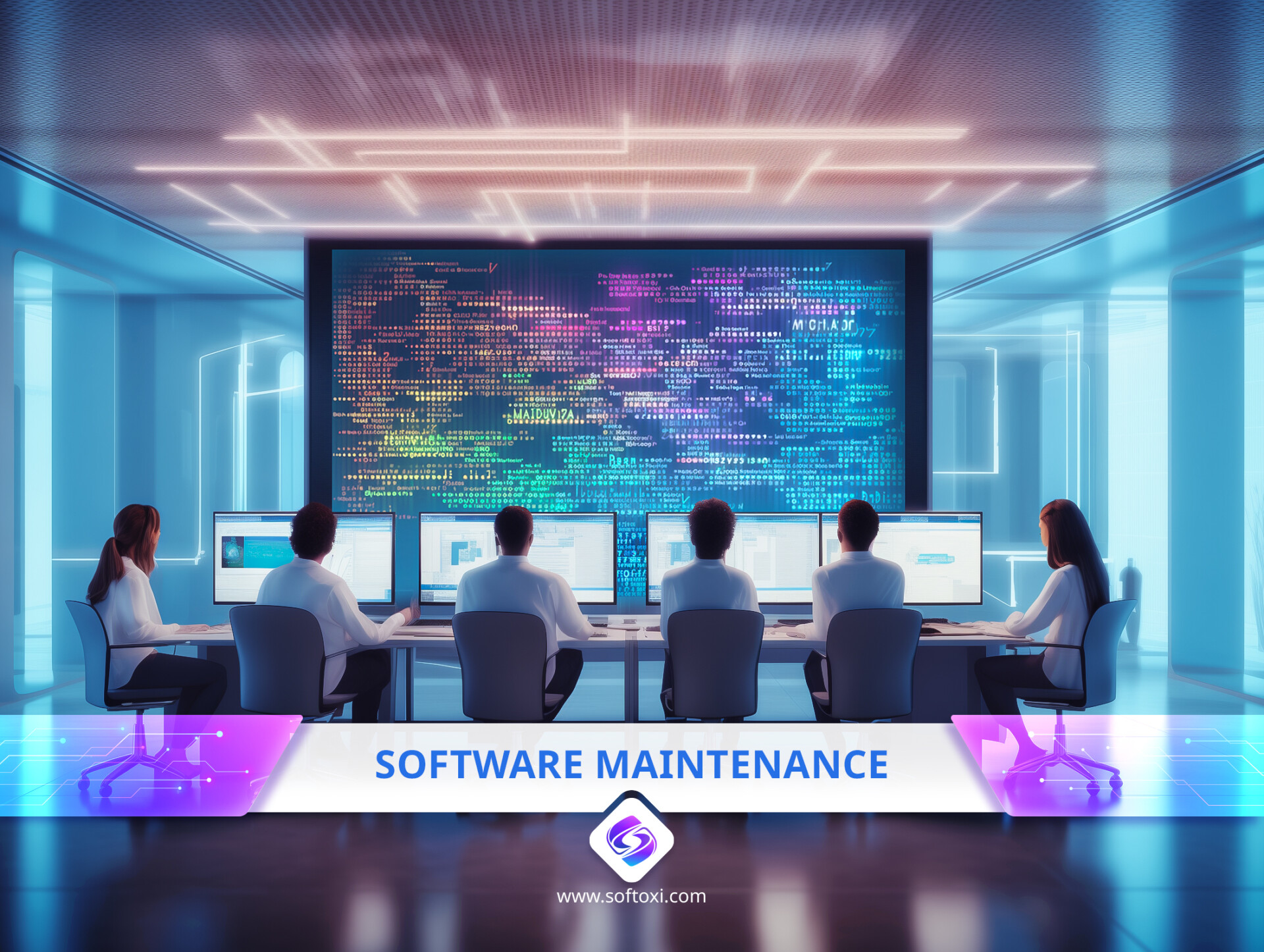Software programs need regular updates and enhancements to ensure they meet your changing requirements. This process of adding new functionalities and fixing issues after the software has been delivered is called software maintenance.
Read on to learn all about the importance of software maintenance, its types, challenges, best practices, and techniques involved.
What Is Software Maintenance?
Software maintenance is similar to driving a car in many ways. After buying a car, you will make additions like new seat covers, fix repair issues, and regularly monitor and service the car to ensure it’s running well.
- Adding new functionalities
- Customizing or modifying existing functions to meet your changing needs.
- Fixing issues
- Monitoring regularly to ensure the software is working as it should.
- Optimizing its use for different use cases and scenarios.
- Migrating the software and its associated data to a new environment.
- Improving the design or architecture to make it more scalable.
- Updating the documentation manuals and technical specifications.
Software maintenance is an essential part of the software lifecycle and ensures the software’s continued relevance to your operations.
Why Is Software Maintenance Important?
“Software maintenance ‘is not keep it working like before.’ It is ‘keep it being useful in a changing world’,” says Jess Kerr, a popular speaker, software developer, and symmathecist.
This quote sums up the importance of maintenance in software systems. Besides keeping your software relevant in a changing world, here are other benefits of software maintenance.
Fixing Bugs
Bug fixing is a priority in application maintenance. Bugs can come up due to lapses in software development, integrations with custom software, changes in workflows, outdated data, and technical reasons like caching. Regardless of the cause, fixing these bugs is necessary for the continued working of the software.
Removing Outdated Functionalities
Often, we tend to focus on adding new capabilities to meet evolving needs. While this is important, what’s equally necessary is to remove the outdated functionalities and codes. Otherwise, the software can become unwieldy, making maintenance difficult and more complex.
Creating New Opportunities
Relevant software can create opportunities to enter new markets. For example, you see a thriving opportunity in a new country and want to explore this geography. But, your application must be relatable to the people of this country. Possibly, it should use localized phrases and languages that reflect the cultural practices to make the software appealing to your new customers. Making such changes is a part of software maintenance, and with effort, you can tap into unexplored markets.
Improving Performance
Your software must not be a drag on your system resources. Rather, it must complement and improve the overall performance of your network. To achieve this, your software requires minor tweaking and even changes to the configuration values.
Meeting Compliance Standards
Compliance standards are constantly changing to keep pace with technological advancements. In turn, you may also have to do adaptive maintenance to ensure that your software complies with the new standards.
Keeping Your System Secure
Cybersecurity needs are rapidly evolving, and your software must not have vulnerabilities that can expose your system to possible cyberattacks. This requires regular patching, depending on the nature of the cyberthreat and the vulnerabilities being exploited.
The above reasons for maintenance can bring up these important questions:
- Are all software maintenance similar?
- Do they help an organization achieve all the mentioned benefits?
There are different types of software maintenance, each with a specific goal.
Types of Software Maintenance
There are four major categories of software maintenance: corrective, preventative, perfective, and adaptive. Let’s take a brief look into what these categories mean.
Corrective Maintenance
Corrective maintenance involves fixing bugs and other software errors. This type of maintenance is critical for the continued use of the software and must be addressed right away.
Preventive Maintenance
Preventive maintenance, as the name suggests, looks to the future and prevents potential software problems. This type of maintenance involves configuration changes, upgrades, and more.
Perfective Maintenance
Organizations and users will get new ideas and applications as they use the software. Perfective maintenance entails the addition of new features and the removal of irrelevant functions. This type of maintenance often has the lowest priority.
Adaptive Maintenance
The business, technological, and regulatory environments are constantly changing. Your software must adapt to these changes, too, and this could require code-level and sometimes even architectural changes. Oftentimes, adaptive maintenance has moderate priority, depending on the nature of the change.
These different types of changes can overlap as well. Prioritizing and addressing these changes is not easy, and this is where some best practices can help.
Best Practices for Software Maintenance
Software maintenance can quickly become overwhelming. Following the best practices discussed below will ensure that your process is streamlined and efficient.
Create a Software Maintenance Plan
A software maintenance plan is a document that describes how your software will be maintained. It can have the following information:
- Currently available functions
- A roadmap for the future
- Priorities
- State of each priority, whether they are assigned or in progress
- Schedule for each maintenance
- The responsible individual or team
- Budget allocation
- Resources needed, including equipment, personnel, and skills
- Impact of third-party variables like policy changes.
- Associated risks.
The above details are more of a guideline on what a good plan should have, but they are not set in stone. In general, the more detailed your plan is, the more clarity and control you can have over your maintenance process.
This document can serve as a blueprint for software maintenance, and it will be the single source of truth for all teams. Such clarity reduces confusion and improves efficiency, as every employee associated with maintenance knows what is required of them.
Estimate the Cost of Software Maintenance
Given that software maintenance is an ongoing activity, it requires a regular budget allocation. But how do you estimate what’s the right budget?
Some factors to include are:
- Labor costs for all the personnel involved, like software engineers, architects, and technicians
- Training costs
- Costs of other software and add-ons
Pro tip: Taking a predictive maintenance approach can reduce unnecessary issues and escalations. Also, using development methodologies like Continuous Integration and Continuous Deployment (CI/CD) pipeline and DevOps reduces the time and the associated costs.
Measure the Effectiveness of Software Maintenance
There are many ways to measure the effectiveness of software application maintenance, depending on the type of work. You can choose the metrics that are most relevant to you.
Below are some possible metrics that you can use:
- Planned Maintenance Percentage (PMP): This metric tells you how much work on a maintenance activity was toward preventive actions and how much was for fixing. Ideally, 90% of the maintenance must be planned.
- Mean Time to Repair (MTTR): The MTTR includes everything from the point of identification to the return to normal operations. Ideally, the MTTR must be as low as possible. A good way to measure this is to map the values in a graph and watch the trends.
- Mean Time Between Failure (MTBF): This is the predicted time between one breakdown and the next during normal operations. The MTBF is calculated as the sum of total operational time divided by the number of failures.
- Preventive Maintenance Compliance: This is the set of preventive work scheduled and completed within a defined time. It is calculated as the number of completed tasks divided by the total number of tasks for a given period multiplied by 100.
- Customer Satisfaction Score (CSAT): The CSAT metric assesses the level of satisfaction among customers. It is measured through surveys or feedback forms.
- First Response Time (FRT): The FRT represents the time it takes for a first response from the support team for a bug or query raised. The lower the score, the better for user satisfaction.
- Service Level Agreement (SLA) Compliance: This metric evaluates compliance to predefined SLA metrics.
- Mean Time to Identify (MTTI): As the name suggests, this metric measures the average time it takes to identify the root cause of a problem. MTTI is a measure of the efficiency of your diagnostic process.
- Costs: The costs and their deviation from budgeted values can provide insights into the efficiency of your software application maintenance.
Improve Software Maintainability
Software maintainability means the intended changes address the goals without creating additional problems or side effects.
Below are some ways to improve software maintainability:
- Follow a consistent coding standard.
- Use sensible names for file names and even variables and functions in your code.
- Add comments as much as possible to help everyone understand why a code change was made.
- Minimize complex issues into simple steps that can be measured.
- Keep the methods small and your code as modular as possible.
- Reduce redundancy in your code.
- Leverage the available repositories instead of creating or subscribing to new ones.
- Remove unused functions and code.
Overall, your goal must be to ensure that anyone who looks into the code understands what’s going on with it.
Manage Software Maintenance Risks
As with any activity, software maintenance also comes with risks. The key is to manage them with minimal downtime and negative consequences.
Here are some ways to manage maintenance risks.
- Take a test-driven approach to development to reduce delays.
- Use source control and version management to avoid code overwrites.
- Invest in automation to bring down cost escalations.
- Focus on documentation.
- Always be aware of the environmental risks and how best to proactively address them.
These are some best practices that can help you prioritize and handle software maintenance tasks. Despite the best-laid plans, many things can go wrong. Understanding the challenges can help you prepare for them and have a contingency plan in place.
Challenges of Software Maintenance
Software maintenance comes with its own set of challenges. When you are unprepared, these challenges can have a serious impact on your organization’s operations and even potentially on customer satisfaction and revenue.
Below, we’ll look at three key challenges associated with maintenance.
Software Maintenance Debt
Software maintenance debt is the consequence that comes due to poor design choices, inefficient code, and any missteps or shortcuts taken during development or maintenance. Besides increasing the time and costs of maintenance, software debt can also impact existing systems and their performance.
To address this maintenance debt, consider:
- Refactoring your tasks
- Allocating dedicated time for cleaning the code
- Establishing standards and guidelines for coding
Software Systems in a Changing Environment
User requirements and the business and regulatory environment can change over time. Your software must adapt to these changes so it continues to add value to your operations. However, this adaptability is not easy.
To make your maintenance process adaptable, you need to:
- Use a development approach like Scrum that supports frequent iterations.
- Maintain clear channels of communication.
- Prioritize tasks based on their importance.
Coordinate Software Maintenance With Other Software Development Activities
Another challenge is to coordinate maintenance with development and allocate resources accordingly. Often, resources and expertise have to be shared, requiring prioritization and even potential conflicts.
To streamline maintenance and developmental activities,
- Establish a knowledge base to share insights.
- Conduct regular meetings to encourage collaboration, pair programming, and joint code reviews.
- Implement code commenting.
Along with the above strategies, you also need appropriate tools to implement them.
Tools and Techniques for Software Maintenance
Software maintenance tools and techniques involve making design changes, updating code, and maintaining documentation to ensure that every stakeholder is aware of the changes. Also, it’s important to create a system to measure these changes and identify their impact.
Such tasks require the extensive use of tools that go beyond just code editors.
Below are some handy tools that can help with software maintenance.
| Tool name | Description | Examples |
|---|---|---|
| Code editors | Code editors are used by programmers to write and edit code. They come with many features like auto-completion and version control. | Visual Studio Code, Sublime Text, Codespaces, Vim, and Buffer Editor. |
| Compilers | Compilers analyze the source code and convert it into the bytecode that can be executed by the target system. | Javac, Free Pascal, Gcc, Clang, Kotlin, and Microsoft Visual C++. |
| Linkers | These tools take one or more object files and combine them into an executable or library file. | Binutils, Microsoft’s linker, Id64, and LLVM. |
| File comparator | The file comparator puts two files side to side and highlights their differences. | PyCharm, File Compare, and Beyond Compare. |
| Version control | Version control is a tool that tracks and manages changes to source code. | Git, Perforce, Mercurial, Panvalet, Vault, and Darcs. |
| Cross-reference generator | This tool ensures that code changes comply with the guidelines of the existing code. Also, lists down the impacted components. | CREF and Cxref |
| Project management tool | Aside from identifying and tracking software bugs, this tool makes it easy to plan and organize releases. | JIRA, Trello, and Asana. |
| Automation software | This useful tool can automate software maintenance processes, including testing and deployment. | Jenkins, Ansible, and TeamCity |
| Selenium | This automated testing tool helps test web-based software. You can even create automated tests to check specific functionalities and workflows. | Selenium, Appium, Cypress, and Katalon Studio. |
| Code quality management tool | This tool helps developers maintain the quality of their code. Plus, it offers the following features: code coverage reports, duplication detection, and code reviews. | SonarQube, Embold, Coverity, and Klocwork. |
| Logging and monitoring tools | Logging and monitoring tools help you stay on top of issues in real time. These tools come with centralized dashboards for tracking and analyzing software issues. | Splunk, Datadog, and SolarWinds. |
From the above discussion, it’s clear that maintenance is as challenging as software development. It requires the use of extensive tools and techniques coupled with an in-depth understanding of software development practices. Given its critical role, there are many software maintenance career opportunities available.
Career Opportunities in Software Maintenance
Whether you’re starting off or have many years of experience, you can find a rewarding career in software maintenance.
Types of Software Maintenance Jobs
Below are some software maintenance roles to choose from:
- The service delivery manager is responsible for team building, setting processes, assigning priorities, and ensuring that everything is working fine.
- The team leader heads the team of engineers and is often responsible for their productivity, training, and efficiency. Team leaders take care of their team members and their well-being.
- Maintenance engineers are responsible for completing the specific tasks assigned to them. There can be many levels within this role, like a junior engineer and a senior engineer.
- Business analysts are responsible for gathering information about user preferences and changing business needs, and the same is passed on to the maintenance team. In this sense, business analysts act as a bridge between the market and the development team.
- The software architect position is often a shared role. The architect is involved when major changes are needed to the system architecture.
- UX/UI designers handle any changes to the user interface and front-end development.
- QA engineers are responsible for testing the code and ensuring it meets the requirements.
- The scrum master applies project management methodologies and processes to improve team efficiency. Conducting Daily Standup Meetings (DSMs) and interacting one-on-one with team members are their primary tasks.
Depending on the requirements, type of software, the nature of industries, and other pertinent factors, a software maintenance team can include a few roles. Often, maintenance engineers and team leads/service delivery managers form the core team while the other roles may be shared between the development and maintenance teams.
According to Glassdoor, the average salary for software maintenance is $76,193 per year. Additional pay can include bonuses, overtime, and profit sharing.
Skills and Experience
If you’re serious about a career in software maintenance, you must develop the skills to excel in it. It’s always a plus to have certifications in various areas of software application maintenance.
Some key skills needed for the role of a maintenance engineer are:
- Expertise in Python, Java, C++, and other programming languages
- A comprehensive understanding of hardware and architecture
- Know-how to use relevant tools like code editors and compilers
- A basic awareness of cybersecurity
- Good language skills for communication and documentation
- Working knowledge of databases
If you’re a tester, you must know the principles and techniques of unit, regression, and integration testing.
The more in-depth your knowledge and experience, the higher your chances of having a lucrative career in this field. Also, the Bureau of Labor Statistics predicts this industry will grow by 25% from 2022-2032, presenting ample opportunities for people with the right skills and experience.
Software Maintenance: Leverage It for Your Organization
Maintaining existing software is essential to building up the security of the organization, fixing issues as they come up, and adding new features to meet the changing business landscape. Depending on the nature of the work, software maintenance can fall into four categories – adaptive, preventive, perfective, and corrective.
Given the importance of software maintenance and its complexity, it’s ideal to include best practices as a part of the process. However, there can still be many challenges, and the organization has to come up with clear strategies to handle them. Along with strategies, they can also use software tools to ease the process of communication and coordination.
In all, this industry is growing rapidly because there are thousands of software applications in use today, and maintaining them requires knowledgeable and experienced individuals. If you have a passion for coding and are looking for a lucrative career, software maintenance is a good choice for you.




